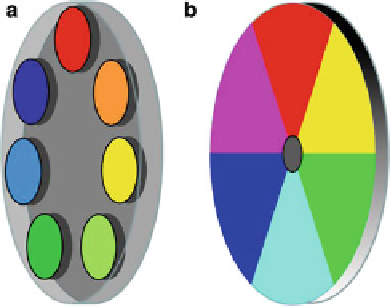Biomedical Engineering Reference
In-Depth Information
Fig. 4.6 a
A straightforward method for spectral imaging using a set of filters mounted on a
rotatable wheel. The filters' properties can be optimized for the application or standardized to have
the same bandwidth and spacing all across the spectrum.
b
A filter wheel that is designed to operate
at a constant rotation speed respective to each band's exposure, field of view, and acquisition time
so that image acquisition become continuous and thus faster
Improved versions include the use of a circular-variable filter (CVF) [
21
]orthe
use of filters that are touching each other (Fig.
4.6
b) so that the wheel can operate
with a constant and fast rotation without having to stop at each filter. This way, a
much faster acquisition time can be achieved. As explained above, the operation
speed is mainly limited by the pixel rate of the camera and the required field of view
that is projected on to the CCD. With high frame-rate CCDs, it is possible to achieve
a full spectral image of 6 spectral bands at a frame rate of 60 frames per second [
19
]
and even higher.
4.4.2.1
Variable Filters
Variable filters provide a much more advanced technique to measure one wavelength
at a time. These filters are more compact and robust and they do not require moving
parts. Two well-known devices are the
liquid crystal tunable filter
(LCTF) [
22
]
shown in Fig.
4.7
and
acousto-optical tunable filter
(AOTF) [
23
,
24
]asshownin
Fig.
4.9
. In the following section, we will describe their method of operation and
capabilities.
LCTF
The most common LCTF system is based on the Lyot design as developed by
Bernard Lyot in 1933 [
25
]. It transmits a narrow-band wavelength by applying a
voltage on a polarizable liquid crystal mounted between two linear polarizers and a
fixed retarder (Fig.
4.7
a). The liquid crystal acts as a variable birefringent material

Search WWH ::

Custom Search